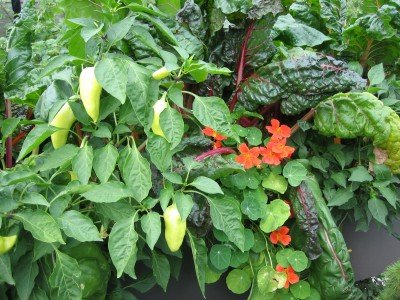
I have a bright, hot spot on my front stone steps with enough space for three containers to greet visitors as they come up the path. The stone holds heat, which in turn is radiated into the containers and heats the soil. Many plants prefer cool soil around their roots and wouldn’t like this location, but for two years I’ve done well with ‘Tropicana’ canna lilies. Their breeding stretches back to tropical South America, and my hot stone steps suit them.
This year I want to try something different, and I’ve ordered seed for heat-loving dwarf vegetables with ornamental features. Watching a vegetable plant grow and develop fruits is an addictive preoccupation, and draws me out to check if there’s been a centimetre of growth between breakfast and lunch times.
What makes a vegetable a good candidate for container gardening? Well, it needs to be miniaturized, reduced to dwarf proportions by years of breeding, so that at maturity it will produce fruit in a confined space. Just like a too-big suit of clothes, the roots must be taken in, branch length shortened, the width of foliage made narrower and the eventual fruits reduced in girth so they won’t pull away from their stems. The final result isn’t a freak of plant breeding haberdashery, but a healthy, attractive and productive plant that just happens to be smaller than its cousins sprawling in the vegetable patch. You might have noticed new cherry tomatoes like ‘Siderno Hybrid’ and ‘Totem’, and mini lettuces like ‘Pearl’ (damseeds.com) specifically bred for containers. It possibly took two decades of breeding work to bring them to their dwarf size, and just in time for your summer containers.
First to catch my attention this year is an All America Selections winner, ‘Fairy Tale’ eggplant (veseys.com). AAS grows vegetables in trial gardens across North America, including Canada, to identify successful, high-performance food and ornamental plants in a broad range of climates. Plants with the AAS designation are strong, resilient and offer assurance that with good care, the plant will thrive in your garden. ‘Fairy Tale’ is a dwarf eggplant growing 18 to 24 inches (45 to 60 cm) tall, with scaled-down leaf size and branch extension. The flushes of lovely purple flowers turn into clusters of long, cylindrical light purple fruits striped with white. They can be picked at four inches (10 cm) or allowed to remain and grow larger, and are sweet tasting, with no bitterness and few seeds. Best of all, eggplant likes a warm root zone, so my front steps will provide the bottom heat they relish.
As companion plants I’ve selected ‘Window Box Roma’ tomato (veseys.com), a dwarf tomato growing to 18 inches (45 cm) and bred specifically for containers. It has a graceful spreading habit, with clusters of pear-shaped fruits with good eating quality. However, tomatoes prefer cooler soil in their root zone, so I’ll give the container a boost up with pot feet, little devices that lift and allow air to circulate under a container. I’ll have one pot of ‘Lipstick’ sweet pepper (johnnyseeds.com), a compact, 24-inch (60-cm) plant with horn-shaped four-inch (10-cm) green fruits that turn red if left to mature. One benefit of scaled-down dwarf plants is that they mature early, and I expect to be picking lovely vegetables 60 days after setting seedlings out in containers.
Growing container vegetables requires conscientious watering if you expect good fruit quality. I use lightweight, 16-inch (40-cm) plastic pots filled with soilless mix amended with extra vermiculite, which helps hold more moisture in the growing medium. I also mix in a time-released container plant fertilizer (14-14-14) to feed plants through the growing season. Mulching with a two-inch (5-cm) layer of shredded bark helps prevent moisture from evaporating.
Okay, now what delicious things will be growing in your containers this summer?
Zinnia news
I’m a fool for zinnias. They’re such confident plants—big, bold and bright, blooming for the entire season, and providing armloads of stems for vases. Zinnias are sun-loving plants with intense primary colours and soft pastels available in dahlia-form double flowers stuffed with closely packed petals.
Clear lime green ‘Envy’ and softer ‘Queen Lime’ (parkseed.com) are intriguing flowers to mix into garden bouquets. The ‘Profusion’ series (with in-bred mildew tolerance) has single and semi-double flowers on 12-inch (30-cm) stems, going against the trend to increase petal count in just about every imaginable ornamental species. These are good for rockeries or for containers in hot, bright locations.
I plan to revisit early memories and plant ‘Peppermint Stick’ zinnias (stokeseeds.com), which has 28-inch (70-cm) stems with fat double blooms and petals flecked with contrasting colours. My colleague, Stephen Westcott-Gratton, once told me gardening is mostly about recreating childhood, and he’s right.

Hi Judith,
This is a great article – a lot of folks will love the fun container varieties you mentioned! I’d like to suggest another great source for amazing zinnias! Sustainable Seed did about an acre of Zinna trials – you can see some of the varieties here: http://sustainableseedco.com/zinnas/
Thanks!
I like to use pots of flowers to fill holes in my perennial gardens, but this year I am going to get double
the pleasure by using miniature vegetables. Thanks for the article and seed sources.
Thanks for those great zinnia suggestions. My orders have already been sent; maybe I'll have to haul out the catalogues again. A